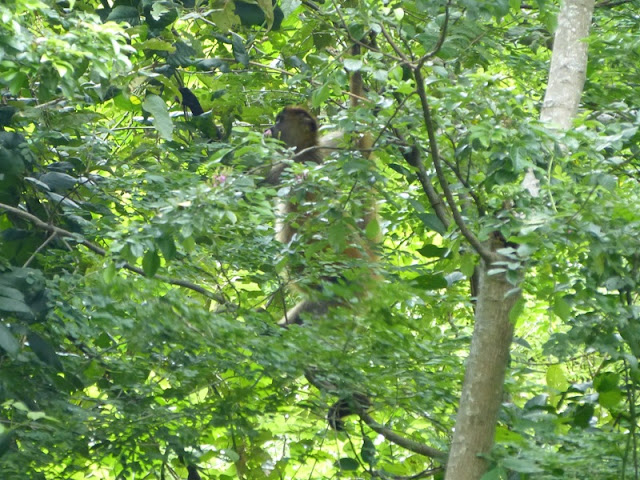I noticed the odd Satyr among the vegetation in the shadier spots and I assumed they were Hermes Satyrs, like I had seen at the hotel a few metres away. However, when I was looking at my photographs I noticed that they were a bit different and they turned out to be One-pupil Satyrs, Cissia similis.
A couple of days later I discovered that some of them were Two-pupil Satyrs, Cissia themis! It just showed the value of taking pictures of every butterfly I saw.
One day when I was walking along the track I heard a crashing in the trees above me and I was thrilled to see a troop of Spider Monkeys proving that it is less easy to spot wildlife when the trees are in leaf!
We had much better views of Spider Monkeys on our day trip to Nicaragua.
Back to the track where there was a bush with red flowers, possibly Aphelandra, which proved to be a real magnet for hummingbirds and butterflies.
It seemed particularly attractive to yellow butterflies, such as the Cloudless Sulphur, Phoebis marcellina,
the Orange-barred Sulphur, Phoebis philea,
and the Large Orange Sulphur, Phoebis agarithe.
All along the track I saw Banded Peacocks, Anartia fatima, the most common butterfly in Costa Rica and Central America. It is found in open areas and roadsides and is said to benefit from the weeds that grow in areas disturbed by humans.
I am not sure what this bird is that I saw in a grass field near the hotel. (Thank you David for identifying it as a Double-striped Thick-knee, Burhinus bistriatus)
A shame I can't see its knees!!
Continued on my next post.











Your bird is a Double-striped Thick-knee (Burhinus bistriatus).
ReplyDeleteThank you David. I didn't know where to start with this one. What a great name!!
DeleteI read about the Cissia and the butterfly is referred to as a satyr because "the name "Satyrinae" (or Satyrids) is a reference to the satyrs of Greek mythology, woodland deities known for their revelry, and the butterfly's habitat and flight reminded early biologists of these creatures. Satyr butterflies exhibit a flight pattern characterized by a "bobbing" or "scurrying" motion close to the ground, often seen in open fields and woodlands. A "bobbing" or erratic flight pattern in a butterfly, characterized by quick, unpredictable changes in direction and altitude, is a defense mechanism against predators, making it difficult for them to track and catch the butterfly."- AI search
ReplyDeleteIt looks like the hummingbird in the image is the 'The cinnamon hummingbird' (Amazilia rutila), native to Central America. I love Spider Monkeys!
Thank you Maria. The Satyrs certainly did have an erratic flight and tended to fly close to the ground. They were pretty difficult to follow and were easily disturbed. This humming bird was quite large compared to others I saw. However, I didn't manage to photograph any of the others as they whizzed between flowers.
DeleteThe Spider Monkeys were a real thrill. The Capuchins at the hotel were great fun, but these seemed more like true wild monkeys!!
Hello Nick :)
ReplyDeleteThank you for your comment. I was on my way to visit you when I saw it.:) Your post is lovely. I appreciate the beautiful butterflies but also the birds and Spider Monkey. I was thrilled just looking at your close photo of the Spider Monkey. Perhaps you were inspired to photograph other species, like more birds, as they are so colourful in Costa Rica. I have only seen the Brimstone lately, but quite a few, and the Cabbage Whites are plentiful, but it's a joy to see both after a cold rainy winter.
All the best
Sonjia.
It has been ages since I last visited your blog, I think, and it has been a great pleasure to find your posts about Costa Rica. My wife and I visited that marvellous country in 2023 and we enjoyed it very much. I saw a few interesting butterflies, which are probably very common there, but they were new to me. Thanks for sharing your observations!
ReplyDeleteThank you Guillermo. I enjoyed reading your blog about your visit to Costa Rica before we visited. This was going to be a once-in-a-lifetime holiday, but now I need to go back when hopefully the weather will be better and we would be able to visit more of the country and national parks. I really loved the small area around the hotel despite the frustration of the poor weather.
Delete